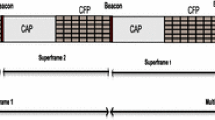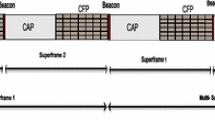Abstract
Time Slotted Channel Hopping (TSCH) is one of the Medium Access Control methods proposed in the IEEE 802.15.4e standard to deal with the requirements of the industrial Wireless Sensor Networks (WSNs), especially in terms of high reliability and low latency. The key feature of the TSCH method is the combination between a time slotted access with a channel hopping, while considering both shared and dedicated links. The latter are essential for ensuring transmissions without loss and additional delays. Therefore, the objective we are seeking to reach in this paper is to demonstrate the benefit use of dedicated links on industrial WSNs-based 802.15.4e TSCH method. To this end, we propose an analytical model-based Markov chains for the TSCH method taking into account the dedicated links, and we estimate the transmission probability \(\tau \) of a data packet. The latter will be then used to develop others analytical models, in order to derive a number of performance metrics, namely the average access delay, the reliability, the throughput, and the energy consumption. Furthermore, to validate the analytical model, we perform extensive simulations-based Monte-Carlo. Finally, to give credibility to the obtained simulation results, we compute \(95\%\) confidence intervals. Numerical results show that increasing the number of dedicated links reduces significantly the retransmission probability offering best network performances in terms of average access delay, reliability and throughput.

























Similar content being viewed by others
References
Wu J, Guo S, Li J, Zeng D (2016) Big data meet green challenges: greening big data. IEEE Syst J 10(3):873
Miorandi D, Uhlemann E, Vitturi S, Willig A (2007) Guest Editorial: Special section on wireless technologies in factory and industrial automation. IEEE Trans Ind Inform 3(2):95
Platt G, Blyde M, Curtin S, Ward J (2005) Distributed wireless sensor networks and industrial control systems-a new partnership. In: The second IEEE workshop on embedded networked sensors, EmNetS-II. IEEE, pp 157–158. https://doi.org/10.1109/EMNETS.2005.1469112
Sikandar A, Kumar S (2014) Performance analysis of interference aware power control scheme for TDMA in wireless sensor networks. In: Kumar K, Malay, Mohapatra, Durga P, Konar, Amit, Chakraborty, Aruna (eds) Advanced computing, networking and informatics, vol 2. Springer, pp 95–101
Accettura N, Piro G (2014) Optimal and secure protocols in the IETF 6TiSCH communication stack. In: IEEE 23rd international symposium on industrial electronics (ISIE). IEEE, pp 1469–1474. https://doi.org/10.1109/ISIE.2014.6864831
Kurunathan H, Severino R, Koubaa A, Tovar E (2018) IEEE 802.15.4e in a Nutshell: Survey and Performance Evaluation. IEEE Commun Surv Tutor 20(3):1989–2010. https://doi.org/10.1109/COMST.2018.2800898
IEEE Standard for Local and metropolitan area networks–Part 15.4: Low-Rate Wireless Personal Area Networks (LR-WPANs) Amendment 1: MAC sublayer. IEEE, pp 1–225 (2012)
Guglielmo DD, Nahas BA, Duquennoy S, Voigt T, Anastasi G (2017) Analysis and experimental evaluation of IEEE 802.15.4e TSCH CSMA-CA algorithm. IEEE Trans Veh Technol 66(2):1573. https://doi.org/10.1109/TVT.2016.2553176
Dariz L, Ruggeri M, Malaguti G (2013) A proposal for enhancement towards bidirectional quasi-deterministic communications using IEEE 802.15.4. In: 21st Telecommunications Forum Telfor (TELFOR), pp 353–356. https://doi.org/10.1109/TELFOR.2013.6716242
Berger A, Pichler M, Haselmayr W, Springer A (2014) Energy-efficient and reliable wireless sensor networks: an extension to IEEE 802.15.4e. EURASIP J Wirel Commun Netw 1:126. https://doi.org/10.1186/1687-1499-2014-126
Anwar M, Xia Y (2014) IEEE 802.15.4e LLDN: superframe configuration for networked control systems. In: Proceedings of the 33rd Chinese control conference, pp 5568–5573. https://doi.org/10.1109/ChiCC.2014.6895891
Ouanteur C, Aïssani D, Bouallouche-Medjkoune L, Yazid M, Castel-Taleb H (2017) Modeling and performance evaluation of the IEEE 802.15.4e LLDN mechanism designed for industrial applications in WSNs. Wirel Netw 23(5):1343. https://doi.org/10.1007/s11276-016-1226-y
Sahoo PK, Pattanaik SR, Wu SL (2017) Design and analysis of a low latency deterministic network MAC for wireless sensor networks. Sensors 17(10):2185. https://doi.org/10.3390/s17102185
Willig A, Matusovsky Y, Kind A (2017) Relayer-enabled retransmission scheduling in 802.15.4e LLDN—exploring a reinforcement learning approach. J Sens Actuator Netw 6(2):6. https://doi.org/10.3390/jsan6020006
Jeong WC, Lee J (2012) Performance evaluation of IEEE 802.15.4e DSME MAC protocol for wireless sensor networks. In: First IEEE workshop on enabling technologies for smartphone and internet of things (ETSIoT). IEEE, pp 7–12. https://doi.org/10.1109/ETSIoT.2012.6311258
Lee J, Jeong WC (2012) Performance analysis of IEEE 802.15.4e DSME MAC protocol under WLAN interference. In: International conference on ICT convergence (ICTC), pp 741–746. https://doi.org/10.1109/ICTC.2012.6387133
Capone S, Brama R, Ricciato F, Boggia G, Malvasi A (2014) Modeling and simulation of energy efficient enhancements for IEEE 802.15.4e DSME. In: Wireless telecommunications symposium (WTS). IEEE, pp 1–6. https://doi.org/10.1109/WTS.2014.6835017
Lee YS, Chung SH (2016) An efficient distributed scheduling algorithm for mobility support in IEEE 802.15.4e DSME-based industrial wireless sensor networks. Int J Distrib Sens Netw 12(2):9837625. https://doi.org/10.1155/2016/9837625
Vallati C, Brienza S, Palmieri M, Anastasi G (2017) Improving network formation in IEEE 802.15.4e DSME. Comput Commun 114:1. https://doi.org/10.1016/j.comcom.2017.09.016
Palattella MR, Accettura N, Dohler M, Grieco LA, Boggia G (2012) Traffic aware scheduling algorithm for reliable low-power multi-hop IEEE 802.15.4e networks. In: IEEE 23rd international symposium on personal, indoor and mobile radio communications (PIMRC), pp 327–332. https://doi.org/10.1109/PIMRC.2012.6362805
Accettura N, Vogli E, Palattella MR, Grieco LA, Boggia G, Dohler M (2015) Decentralized traffic aware scheduling in 6TiSCH networks: design and experimental evaluation. IEEE Internet Things J 2(6):455. https://doi.org/10.1109/JIOT.2015.2476915
Duy TP, Dinh T, Kim Y (2017) Distributed cell selection for scheduling function in 6TiSCH networks. Comput Stand Interfaces 53:80. https://doi.org/10.1016/j.csi.2017.03.008
Guglielmo DD, Seghetti A, Anastasi G, Conti M (2014) A performance analysis of the network formation process in IEEE 802.15.4e TSCH wireless sensor/actuator networks. In: IEEE symposium on computers and communications (ISCC), pp 1–6. https://doi.org/10.1109/ISCC.2014.6912607
Vogli E, Ribezzo G, Grieco LA, Boggia G (2015) Fast join and synchronization schema in the IEEE 802.15.4e MAC. In: IEEE wireless communications and networking conference workshops (WCNCW). IEEE, pp 85–90
Du P, Roussos G (2012) Adaptive time slotted channel hopping for wireless sensor networks. In: 4th Computer science and electronic engineering conference (CEEC). IEEE, pp 29–34. https://doi.org/10.1109/CEEC.2012.6375374
De Guglielmo D, Anastasi G, Seghetti A (2014) Advances onto the internet of things. Springer, Berlin, pp 135–152
Alves RCA, Margi CB (2016) IEEE 802.15.4e TSCH mode performance analysis. In: IEEE 13th international conference on mobile ad hoc and sensor systems (MASS), pp 361–362. https://doi.org/10.1109/MASS.2016.054
Vilajosana X, Wang Q, Chraim F, Watteyne T, Chang T, Pister K (2014) A realistic energy consumption model for TSCH networks. IEEE Sens J 14(2):482. https://doi.org/10.1109/JSEN.2013.2285411
Al-Nidawi Y, Kemp AH (2015) Mobility aware framework for timeslotted channel hopping IEEE 802.15.4e sensor networks. IEEE Sens J 15(12):7112. https://doi.org/10.1109/JSEN.2015.2472276
Sciancalepore S, Vučinić M, Piro G, Boggia G, Watteyne T (2017) Link-layer security in TSCH networks: effect on slot duration. Trans Emerg Telecommun Technol 28(1):e3089. https://doi.org/10.1002/ett.3089
Ouanteur C, Bouallouche-Medjkoune L, Aïssani D (2017) An enhanced analytical model and performance evaluation of the IEEE 802.15.4e TSCH CA. Wirel Pers Commun 96(1):1355. https://doi.org/10.1007/s11277-017-4241-0
Chen S, Sun T, Yuan J, Geng X, Li C, Ullah S, Abdullah Alnuem M (2013) Performance analysis of IEEE 802.15.4e time slotted channel hopping for low-rate wireless networks. KSII Trans Internet Inf Syst 7(1):1. https://doi.org/10.3837/tiis.2013.01.001
Guglielmo D, Nahas BA, Duquennoy S, Voigt T, Anastasi G (2017) Analysis and experimental evaluation of IEEE 802.15.4e TSCH CSMA-CA algorithm. IEEE Trans Veh Technol 66(2):1573. https://doi.org/10.1109/TVT.2016.2553176
Martin KM, Seetha Ramanjaneyulu B (2020) Priority Based Centralized Scheduling for Time Slotted Channel Hopping Based Multihop IEEE 802. 15. 4 Networks. J Comput Theor Nanosci 17(1):363–372
Mohamadi M, Djamaa B, Senouci MR, Mellouk A (2021) FAN: fast and active network formation in IEEE 802.15.4 TSCH networks. J Netw Comput Appl 183—-184:103026. https://doi.org/10.1016/j.jnca.2021.103026
Hammoudi S, Harous S, Aliouat Z, Louail L (2018) Time slotted channel hopping with collision avoidance. Int J Ad Hoc Ubiquitous Comput 29(1–2):85–102
De Guglielmo D, Anastasi G, Seghetti A (2014) Advances onto the internet of things. Springer, Berlin, pp 135–152. https://doi.org/10.1007/978-3-319-03992-3
Cena G, Demartini CG, Ghazi Vakili M, Scanzio S, Valenzano A, Zunino C (2020) Evaluating and modeling IEEE 802.15.4 TSCH resilience against Wi-Fi interference in new-generation highly-dependable wireless sensor networks. Ad Hoc Netw 106:102199. https://doi.org/10.1016/j.adhoc.2020.102199
Touloum S, Bouallouche-Medjkoune L, Aïssani D, Ouanteur C (2020) Performance analysis of the IEEE 802.15.4e TSCH-CA algorithm under a non-ideal channel. IJWMC 18(1):1. https://doi.org/10.1504/IJWMC.2020.104765
Gardiner C (2009) Stochastic methods, vol 4. Springer, Berlin
Author information
Authors and Affiliations
Corresponding author
Additional information
Publisher's Note
Springer Nature remains neutral with regard to jurisdictional claims in published maps and institutional affiliations.
Rights and permissions
About this article
Cite this article
Touloum, S., Bouallouche-Medjkoune, L., Yazid, M. et al. Performance modeling of the IEEE 802.15.4e TSCH enabling both shared and dedicated links in industrial WSNs. Computing 104, 859–891 (2022). https://doi.org/10.1007/s00607-021-00990-2
Received:
Accepted:
Published:
Issue Date:
DOI: https://doi.org/10.1007/s00607-021-00990-2
Keywords
- Industrial WSNs
- IEEE 802.15.4e standard
- TSCH method
- Dedicated links
- Modeling and analysis
- Simulation and validation




